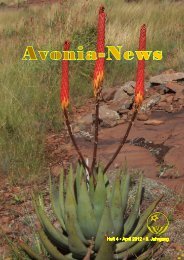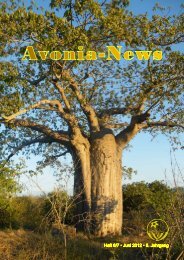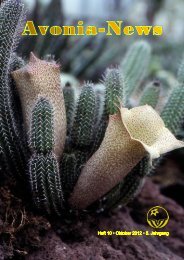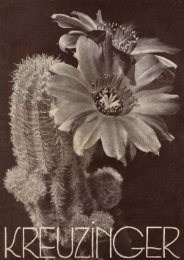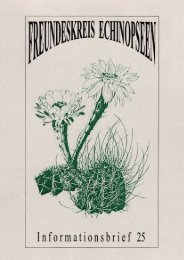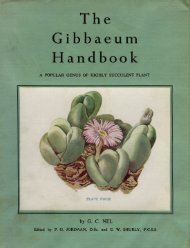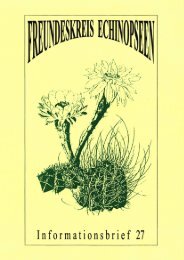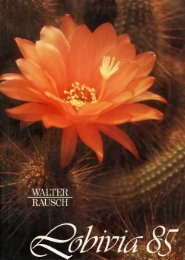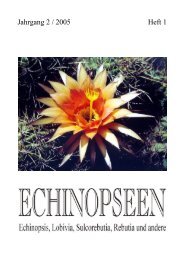- Page 3: L I T H O P S B Y G . C . N E L
- Page 6 and 7: Printed by Hortors Limited, 78, Bre
- Page 8 and 9: page 35. Lithops olivacea 122 36. L
- Page 10 and 11: figure page 46 . Lithops gracilidel
- Page 13 and 14: LIST OF COLOURED PLATES Plate 1 . L
- Page 17 and 18: PREFACE A Monograph on any genus sh
- Page 19 and 20: INTRODUCTION THE name Lithops is de
- Page 21 and 22: which enclose between them the new
- Page 23 and 24: In the ease of Lithops terricolor,
- Page 25 and 26: L. salicola occurs at two places ap
- Page 27: fig. 3 . longitudinal section throu
- Page 30 and 31: It would appear that the top surfac
- Page 32: colouration: (v) L. Fulleri also ha
- Page 35 and 36: As will be described later, its mai
- Page 37 and 38: figure 8 . lithops gracilidelineata
- Page 39 and 40: to the prevailing winds, and being
- Page 41: fig. 13 . capsule of lithops optica
- Page 45 and 46: collected. Dinter’s L. alpina, on
- Page 47 and 48: two leaves entirely. Dinter extende
- Page 49 and 50: VOORWOORD Die oningewyde wat deur d
- Page 51 and 52: Herr und Fr. Goltze, Urikos, Maltah
- Page 53 and 54: togte met kar en osse en onder veel
- Page 55 and 56: ster”, kom (Fig. 3). By sommige s
- Page 57 and 58: Die belangrike rol wat kleur in die
- Page 59 and 60: die top wat die venster bevat, af t
- Page 61 and 62: 33 S > 33° S puntig wees. Hulle is
- Page 63 and 64: L. pseudotruncatella het ’n taaml
- Page 65 and 66: these occasions the plants are cove
- Page 67 and 68: enigermate vir taxonomiese doeleind
- Page 69 and 70: uiters moeilik, wellig onmoontlik w
- Page 71 and 72: BESKRYWING VAN DIE GESLAG. Planteli
- Page 73: plate 1 . lithops aucampiae l. bol.
- Page 76 and 77: figure 16 . lithops aucampiae l. bo
- Page 80 and 81: plate 3 . lithops bella (dtr.) n.e.
- Page 82: figure 17a . lithops bella (dtr.) n
- Page 85 and 86: grey (fawn) colour, the projections
- Page 87 and 88: ander > an der tausende > Tausende
- Page 89: plate 5 . lithops bromfieldii l. bo
- Page 92 and 93:
Hierdie soort is maklik te herken d
- Page 96 and 97:
plate 7 . lithops comptonii l. bol.
- Page 98:
Upington: Geelkop: Dry; Sept. 1939;
- Page 101 and 102:
Lithops chrysocephala. (Plaat 6.) H
- Page 103 and 104:
convex and of unequal size or conve
- Page 105 and 106:
oured, rugose, between the slight e
- Page 107 and 108:
This species is characterised by th
- Page 109 and 110:
9. LITHOPS DIVERGENS Lithops Diverg
- Page 111 and 112:
In dit. van Rhynsdorp: in collibus,
- Page 113:
plate 9 . 1. lithops dorotheae nel
- Page 116 and 117:
figure 35 . lithops eberlanzii (dtr
- Page 118 and 119:
figure 36 . lithops erniana loesch
- Page 121 and 122:
transparent, light green or whitish
- Page 124 and 125:
plate 11 . lithops franciscii (dtr.
- Page 126 and 127:
figure 40 . lithops fulviceps n.e.
- Page 129 and 130:
light dove grey with a slight viola
- Page 131:
plate 13 . lithops fulleri n.e. br.
- Page 135 and 136:
Great Namaqualand, Great Karasberg
- Page 138 and 139:
plate 14a . lithops fulviceps n.e.
- Page 140 and 141:
dunn > dünn figure 45 . lithops gr
- Page 144 and 145:
plate 15a . lithops gracilidelineat
- Page 146 and 147:
figure 47 . lithops gulielmi l. bol
- Page 149 and 150:
✱Lithops Helmuti. Corpuscula in r
- Page 151:
plate 17 . lithops herrei l. bol.
- Page 155 and 156:
or dots, thereby breaking the windo
- Page 158 and 159:
plate 18 . 1. lithops inae nel 2. l
- Page 160 and 161:
figure 53 . lithops inae nel Lithop
- Page 163 and 164:
kort na huilt’ ontvang is. Fig. 5
- Page 165 and 166:
nentibus, saturata rubre brunneis,
- Page 167:
plate 20 . lithops karasmontana (dt
- Page 171 and 172:
out aan te neem dat dit ’n ander
- Page 173 and 174:
figure 59 . lithops karasmontana (d
- Page 176 and 177:
plate 20b . lithops karasmontana (d
- Page 178 and 179:
kunjasenses > kunjasensis figure 62
- Page 181 and 182:
sions. Diam. of flower 3.6 cm.; sep
- Page 183:
plate 21a . lithops kuibisensis dtr
- Page 187 and 188:
Transvaal: Vereeniging; naby Klerks
- Page 190 and 191:
plate 22a . lithops kunjasensis dtr
- Page 192 and 193:
figure 68 . lithops marginata nel E
- Page 196 and 197:
plate 23a . lithops lesliei n.e. br
- Page 198 and 199:
figure 70 . lithops marginata nel j
- Page 201 and 202:
is. Hierdie drie plante was deel va
- Page 203:
plate 25 . lithops marmorata n.e. b
- Page 207 and 208:
Groot Namaqualand: prope Pockenbank
- Page 210 and 211:
plate 27 . 1. lithops mennellii l.
- Page 212 and 213:
figure 76 . lithops meyeri l. bol.
- Page 216 and 217:
plate 29 . lithops nelii schwant.
- Page 218 and 219:
figure 78 . lithops nelii schwant.
- Page 221 and 222:
figure 79 . lithops nelii schwant.
- Page 223:
plate 31 . 1. lithops optica (marl.
- Page 227 and 228:
figure 82 . lithops optica (marl.)
- Page 230 and 231:
plate 33 . lithops pseudotruncatell
- Page 232 and 233:
figure 86 . lithops otzeniana nel 1
- Page 235 and 236:
10 bis 12 teilig > 10 bis 12 teilig
- Page 237:
A, capsule closed; B, half opened;
- Page 240 and 241:
132 figure 89 . lithops pseudotrunc
- Page 244 and 245:
plate 34 . lithops ruschiorum (dtr.
- Page 246:
figure 93 . lithops ruschiorum (dtr
- Page 249 and 250:
amethysino > am ethystino Lithops R
- Page 251 and 252:
figure 95 . lithops salicola l. bol
- Page 253:
plate 35a . 1. lithops salicola l.
- Page 256 and 257:
0-75 > 0.75 5, lateralia 2 diu erec
- Page 260 and 261:
plate 36a . lithops terricolor n.e.
- Page 262:
142 42. LITHOPS TERRICOLOR Lithops
- Page 265 and 266:
figure 102 . lithops terricolor n.e
- Page 267 and 268:
figure 105 . lithops urikosensis dt
- Page 269:
plate 38 . lithops turbiniformis (h
- Page 272 and 273:
figure 109 . lithops van zylii l. b
- Page 276 and 277:
plate 39 . lithops urikosensis dtr.
- Page 278:
parte infima per 1.5 mm. papillata,
- Page 281 and 282:
figure 112 . lithops venteri nel I
- Page 283 and 284:
.” Ich > . “Ich lik in die jong
- Page 285:
plate 41 . lithops van zylii l. bol
- Page 288 and 289:
tig erseheinenden Grübchen von ±
- Page 292 and 293:
plate 42 . 1. lithops venteri nel 2
- Page 294:
figure 117 . lithops weberi nel In
- Page 298 and 299:
figure 119 . lithops weberi nel 160
- Page 300 and 301:
162 50. LITHOPS WEBERI Lithops Webe
- Page 302:
164 figure 121 lithops weberi nel i
- Page 305 and 306:
SLEUTEL VIR DIE SOORTE i. afenestra
- Page 307 and 308:
ii. fenestratae Boonste vlak geheel
- Page 309 and 310:
B. aRubRae. Venster sonder rooi kol
- Page 311 and 312:
xx. Venster gekleurd rooiagtig, per
- Page 313 and 314:
Lithops chrysocephala Nel in Annals
- Page 315 and 316:
of Transvaal, London. 1926. I p. 16
- Page 318:
The author uishes to place on recor




